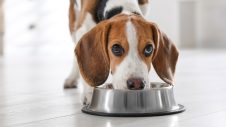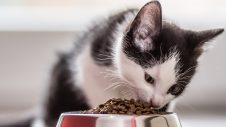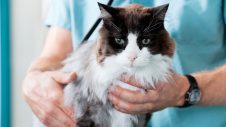When to transition your pet’s food
There are many reasons why you may need to change your pet’s diet. It may be necessary to transition your pet to a new food if your veterinarian has recommended a prescription diet in order to treat a specific health condition. Perhaps after having a nutritional consultation with your vet, you have decided to make the switch to super premium food so that you can give your dog or cat the optimal level of nutrients for their age, breed, and lifestyle. As your pet ages from a puppy or kitten to an adult, or an adult to a senior, they will also require a different level of nutrition. Also, if your pet is pregnant or nursing, they will need to change to a diet more suited for their life stage.
Unlike our stomachs, which can handle a wide variety of foods in a short period of time, dogs and cats need balance in their diet. In all these situations, if you suddenly switch your dog or cat to a new diet, it is likely that they will experience a tummy upset. Vomiting, diarrhoea or soft faeces may be seen. To prevent your pet from this discomfort, it is important that you gradually introduce the new food to their diet.
Recommended transition schedule
Greencross Vets recommend that you transition your pet to their new food over a period of 10-14 days. Some pets may require more time, especially cats who can take a month to adjust. Your vet will be able to provide a personalised transition schedule for your pet.
By slowly increasing the proportion of the new food in their regular meals, you can make the change easier on your pet’s sensitive stomach.

If at any point during this transition period your dog or cat shows signs of an upset stomach (e.g. diarrhoea or vomiting), pause the transition until their stomach has settled. If these symptoms persist, please contact your local Greencross Vets for a checkup.
Food transition tips
Make switching to a new food a smooth process for your pet by maintaining their regular feeding routine. Continue using the same bowl placed in the same area and provide them with food at the same time each day.
If your dog or cat is not finishing their meal, this could be due to the overfeeding of treats outside of their regular meals. While your pet is transitioning to a new food, limit their treats to ensure they rely on their main meals to satisfy their appetite. Cats especially can be fussy eaters. If they are avoiding their new food, you can create more appeal by hand feeding them small amounts to make it seem like a treat for them. Gently warming canned or sachet foods in the microwave enhances the foods’ natural aromas thereby encouraging appetite.
If you are struggling to transition your pet to a new diet, book a consultation with your local Greencross Vet who will be more than happy to provide you with personalised advice.

 Greencross Vets
Greencross Vets 










